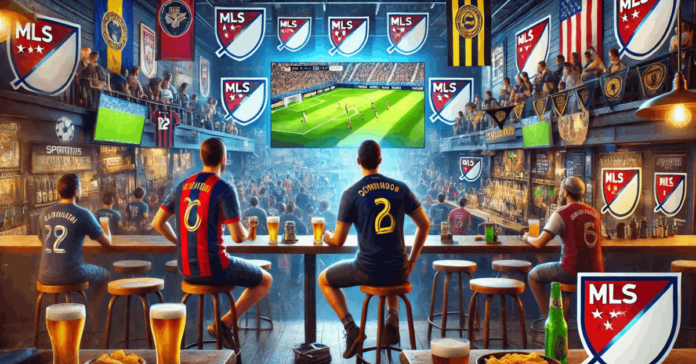
This article is your comprehensive guide to MLS soccer teams, detailing each club and their standout players. You’ll learn about the league’s history, team achievements, and key figures shaping the game.
Whether you’re a seasoned fan or new to the sport, this guide will enhance your understanding and appreciation of MLS. Dive in to explore the dynamic world of Major League Soccer.
History of MLS
The history of this league is rich and fascinating. It highlights its journey from a new venture to a significant player in the sports world.
Formation and Evolution
The league began in 1996 as part of the U.S. bid to host the 1994 World Cup. It started with ten teams and aimed to grow the sport in North America.
Over the years, it expanded, adding more teams and increasing its fan base. Early struggles included financial instability and low attendance.
However, strategic marketing and the arrival of international stars helped turn things around. Today, it stands strong with growing popularity and influence.
Key Milestones and Expansion Impact
Several milestones have marked its journey. The introduction of the Designated Player Rule in 2007 brought global stars to the league.
Expansion teams like LAFC and Inter Miami have significantly boosted its profile. These teams brought new markets, fans, and financial investments.
Each expansion has been a calculated move to strengthen the league’s presence. As a result, the league has seen steady growth in viewership and revenue.
Overview of Teams
The league comprises various clubs spread across North America. These teams are divided into Eastern and Western Conferences.
Current List of Teams
The league is structured into two leading conferences: Eastern and Western. Each conference houses several teams representing different cities and regions.
Eastern Conference Teams:
- Atlanta United FC
- CF Montréal
- Charlotte FC
- Chicago Fire FC
- FC Cincinnati
- Columbus Crew
- D.C. United
- Inter Miami CF
- New England Revolution
- New York City FC
- New York Red Bulls
- Orlando City SC
- Philadelphia Union
- Toronto FC
Western Conference Teams:
- Austin FC
- Colorado Rapids
- FC Dallas
- Houston Dynamo FC
- LA Galaxy
- Los Angeles FC
- Minnesota United FC
- Nashville SC
- Portland Timbers
- Real Salt Lake
- San Jose Earthquakes
- Seattle Sounders FC
- Sporting Kansas City
- St. Louis CITY SC
- Vancouver Whitecaps FC
Team Histories and Achievements
Each team has a unique history and list of achievements. For instance, the LA Galaxy, based in Los Angeles, has won multiple championships.
New York City FC, founded in 2013, quickly became a competitive team. Established in 2014, Atlanta United has a passionate fan base and won a title in their second season.
Teams like Toronto FC and Seattle Sounders have also made significant impacts. The diversity and achievements of these clubs contribute to the league’s vibrant and competitive nature.
Key Players in MLS
This section highlights significant players who have made an impact in the league. It covers both past legends and current stars.
Marquee Players from Past to Present
The league has seen many marquee players over the years. David Beckham, who joined LA Galaxy in 2007, brought global attention to the league.
Landon Donovan, known for his time with LA Galaxy, is a legend and all-time leading scorer. Thierry Henry’s tenure with the New York Red Bulls added European flair to the league.
More recently, Zlatan Ibrahimović’s stint with LA Galaxy drew headlines and fans. These players have performed well and increased the league’s visibility.
Profiles of Current Standout Players
Carlos Vela of Los Angeles FC is known for his exceptional scoring ability and creative play. Josef Martínez from Atlanta United has been a prolific striker, breaking multiple records.
Alejandro Pozuelo, playing for Toronto FC, is celebrated for his vision and passing skills. Young talents like Gianluca Busio are making their mark with impressive performances.
With their diverse backgrounds, these players bring unique skills to their teams. Their contributions are vital in keeping the league competitive and exciting.
Fan Culture and Support
Fan culture is a significant league aspect, enhancing the matchday experience. This section explores the dedicated fan groups and their impact on the league.
Fan Groups, Rivalries, and Traditions
Each team has its passionate fan base. Supporter groups like LAFC’s 3252 and Seattle Sounders’ Emerald City Supporters are known for their vibrant presence.
Rivalries, such as the one between Portland Timbers and Seattle Sounders, create intense matchups.
Traditions like Tifo displays and coordinated chants add to the atmosphere. Thanks to these dedicated fans, matchdays are filled with energy.
Impact on Team Performance and Popularity
Fan support plays a crucial role in team performance. Home advantage is often bolstered by loud, supportive crowds.
Teams with strong fan bases tend to perform better, as seen with clubs like Seattle and Atlanta. The popularity of the league has grown significantly due to the enthusiasm of these supporters.
They also help increase the league’s visibility through social media and community activities. The league’s success is closely tied to its fans’ dedication.
MLS Season Structure
The season has a unique format, including a regular season, playoffs, and a championship. Here’s a detailed breakdown to help you understand it better.
Breakdown of the Regular Season, Playoff Format, and Championship
The season is divided into different stages, each with its significance:
- Regular Season: Teams play against each other within their conference and a few cross-conference matches. Points are earned for wins and draws.
- Playoffs: The top teams from each conference qualify for the playoffs. These are knockout rounds leading to the championship.
- Conference Semifinals and Finals: The best teams from the playoffs compete to become conference champions.
- Championship Match: The winners of the Eastern and Western Conferences face off in the final match, known as the MLS Cup.
- Supporters’ Shield: Awarded to the team with the best regular season record.
- Season Schedule: The season typically runs from early spring to late fall, culminating in the championship in December.
All-Star Game and International Competitions
The All-Star Game features top players selected from the league to play against an invited team, showcasing talent and entertaining fans.
International competitions, such as the CONCACAF Champions League, allow clubs to compete against top teams from other regions.
Success in these tournaments enhances the league’s reputation globally. These events highlight the league’s growth and the quality of its players. Participating in international competitions also helps clubs gain valuable experience.
Youth Development and Academies
Youth development is crucial for nurturing new talent. This section explains how academies play a vital role in this process.
Role of Youth Academies in Developing Talent
Youth academies are essential for finding and training young players. They provide structured training programs to develop technical skills and understanding of the game.
Many current stars began their careers in these academies, showing their effectiveness. Academies are affiliated with professional teams, offering a clear path to the top.
Players receive coaching, education, and support, helping them grow on and off the field. This system ensures a steady supply of talented players for the league’s future.
Economic Aspects of MLS
The league’s financial structure is unique and crucial for its operations. Here’s a look at how money influences teams and the league overall.
Salary Cap and Designated Player Rule
The league uses a salary cap to control team spending, ensuring competitive balance. Teams can sign up to three designated players whose salaries are exempt from the cap, allowing for star acquisitions.
This rule has attracted high-profile players from around the world. The salary cap and designated player rule shape how teams build their rosters.
These mechanisms help maintain financial stability while allowing for star power. As a result, teams can stay competitive without overspending.
Sponsorships, Broadcasting Rights, and Financial Growth
Sponsorship deals are a significant revenue source, with companies investing heavily in the league. Broadcasting rights have also grown, with more networks airing games and providing substantial income.
This financial growth has allowed the league to expand and improve infrastructure. Investments in stadiums, training facilities, and youth development are direct results.
The financial success has also helped increase the league’s popularity and fan base. Overall, these factors contribute to the league’s stability and prospects.
Challenges and Future Outlook
The league faces several hurdles as it continues to grow. Here’s a look at current issues and what the future may hold.
Current Challenges
One of the main challenges is competing with more established international leagues. The league also faces competition from other major sports within North America.
Another issue is attracting and retaining top talent while managing salary restrictions. Financial stability remains a concern for smaller clubs.
Balancing growth and maintaining competitive balance is crucial. These challenges require strategic planning and innovation.
Future Trends
Future trends include adding expansion teams to grow the league’s footprint. Technological advancements in sports, like VAR and data analytics, will enhance the game.
Investments in youth academies and facilities are expected to continue. Increasing the league’s presence in international markets is a priority.
Enhanced fan engagement through digital platforms will be important. The future looks promising with careful planning and adaptation.
Final Thoughts on MLS Soccer Teams
This guide comprehensively examines MLS soccer teams, their history, key players, and fan culture. The league has faced and will continue to face challenges, but its growth is evident.
Understanding the economic aspects and future trends provides a complete picture. The dedication of fans and strategic planning will shape the league’s future.






